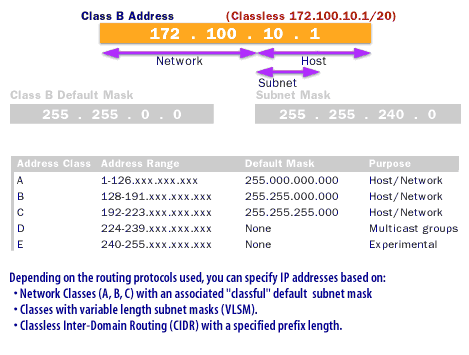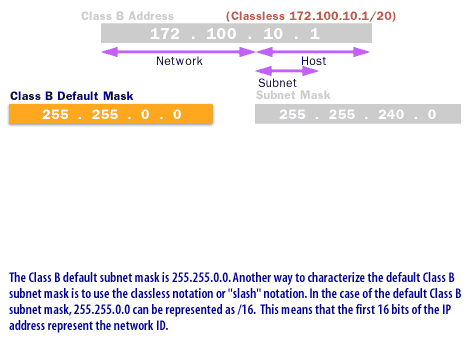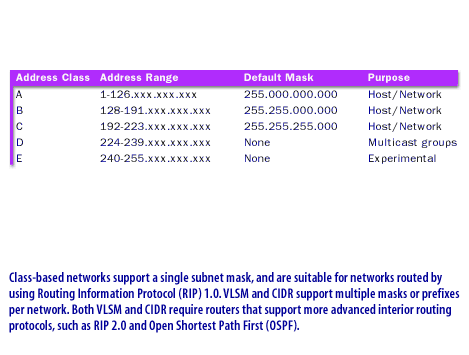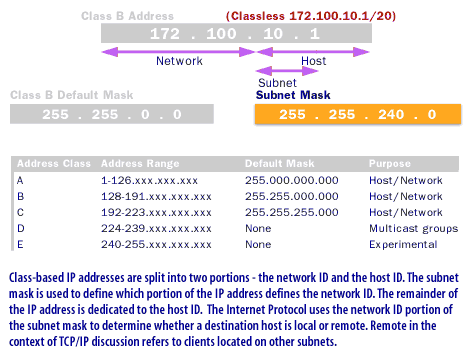| Lesson 5 | Design a functional TCP/IP solution |
| Objective | Define the elements utilized in TCP/IP design. |
Design a functional TCP/IP Solution
To determine the appropriate TCP/IP infrastructure, you must evaluate your Internet accessibility needs, the use of routers, and public IP address availability. To allow peer-to-peer communication, all hosts in a TCP/IP network require unique IP addresses. IP 4.0 supports a 32-bit address structure, publicly administered by a standards body (IETF), which can be used to implement both public and private address structures. The following four factors must be taken into consideration when designing a functional IP network:
This lesson will review IP addressing. Future lessons will look at other essential aspects of designing with TCP/IP.
- The IP address and mask configuration
- The addressing structures for private network operation
- The addressing structures to allow subnet routing
- A methodology for a consistent design of IP networks
This lesson will review IP addressing. Future lessons will look at other essential aspects of designing with TCP/IP.
IP Addressing
Each TCP/IP host is identified by a logical IP address. This address is unique for each host that communicates by using TCP/IP.
Because IP addresseses identify devices on a network, you must assign a unique IP address to each device on the network.
The standard for IP addressing is referred to as IP version 4.0 (v4). The standard uses a 32-bit address field and 32-bit subnet mask field. The following series of images covers the essentials of IP addressing.
Review of IP Addressing, Routing protocols and Subnet masks




IP Addressing Review
Question:
How does a Windows Administrator specify Network Classes (A,B,C) with an associated default subnet mask?
In Windows, network classes (A, B, and C) are defined by their default subnet masks. To specify a network class with an associated default subnet mask, a Windows administrator can do the following:
By specifying a network class with an associated default subnet mask in this way, a Windows administrator can configure the network settings for a Windows computer to match the requirements of the network. This allows the computer to communicate with other devices on the network and access network resources.
In Windows, network classes (A, B, and C) are defined by their default subnet masks. To specify a network class with an associated default subnet mask, a Windows administrator can do the following:
- Determine the network class that is needed based on the number of hosts that will be on the network. A network class A is typically used for very large networks, while network classes B and C are used for smaller networks.
- Determine the default subnet mask for the chosen network class. The default subnet mask for a network class A is 255.0.0.0, for a network class B it is 255.255.0.0, and for a network class C it is 255.255.255.0.
- Open the Network and Sharing Center in Windows and select Change adapter settings.
- Right-click on the network adapter that will be used for the network and select Properties.
- Select Internet Protocol Version 4 (TCP/IPv4) and click Properties.
- Select the option to Use the following IP address.
- In the IP address field, enter the IP address for the network. The first portion of the IP address should match the network class chosen, followed by additional octets that define the specific network address. For example, for a network class B, the IP address might start with 172.16.x.x.
- In the Subnet mask field, enter the default subnet mask for the chosen network class.
- Click OK to save the changes and close the network properties window.
By specifying a network class with an associated default subnet mask in this way, a Windows administrator can configure the network settings for a Windows computer to match the requirements of the network. This allows the computer to communicate with other devices on the network and access network resources.
When using class-based addresses and VLSM, you cannot decrease the number of bits that determine the network ID below the number that is assigned to the default subnet mask. The following table lists and describes the RFCs pertaining to subnet masks.
The next lesson explores IP addressing for a private network.
| RFC | Reference title | Describes |
| 950 | Internet Standard Subnetting Procedure | Subnetting of IP addresses |
| 1518 | An Architecture IP Address Allocation with CIDR | Introduction to the architecture required to support CIDR |
| 1519 | Classless Inter-Domain Routing (CIDR) an Address Assignment and Aggregation Strategy | Designing with route aggregation |
| 1812 | Requirements for IPv4 Routers, Section 4.2.2.11 | All ones and zeros in the IP address mask |
| 1878 | Variable Length Subnet Table For IPv4 | Subnet masking of variable length |
The next lesson explores IP addressing for a private network.